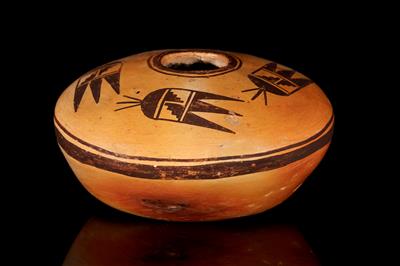Hopi seed jar
Download media
Object number04487.009
TitleHopi seed jar
CreatorHopi Tewa (makers)
DescriptionThis earthenware seed jar is a striking example of Hopi pottery made during the early years of the 20th century. During this period Hopi-Tewa potters revived the use of traditional designs like the maize cobs decorating this jar. The colour changes from a yellow to pinkish orange – this wonderful blushing distinguishes Hopi-Tewa pottery from that of the other Pueblos (villages) of the area.
The Hopi-Tewa are Native American people who now live on the first Mesa of Arizona in the Southwestern United States. They have been making beautiful hand-crafted pieces from clay for centuries. Pottery vessels were an everyday essential, used for cooking, storing food and carrying water. They were also used ceremonially and for trading. The opening up of the country in the 19th century with the expansion of the railroads and the development of tourism offered new opportunities and new markets to the Hopi potters.
The Hopi create their pots using traditional methods handed down through the generations. From basic ingredients – local clay, dug from the earth by hand, and water – they produce objects of exceptional beauty. Their methods today are largely unchanged from those used a thousand years ago.
Hopi pottery is made using a coiling and scraping method. The clay is prepared and then rolled in long ‘sausages’ which are firstly spiralled to make a base, and then coiled upward to make the walls. The walls are scraped and smoothed using sticks or gourds. Left to dry in the air, the pots are decorated using water mixed with clay and either vegetable or mineral dyes. The Hopi traditionally used brushes made from yucca leaves or tiny twigs. Once completed, the pots are fired in an earthen pit, often using animal dung for fuel.
Production placeN. America Arizona
Production date 1900 - 1930
Object namePot (seed jar)
MaterialEarthenware
Dimensions
whole Diameter: 120 mm
whole Height: 55 mm
whole Height: 55 mm

